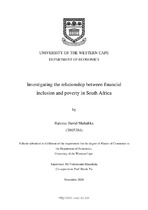| dc.contributor.advisor | Matsebula, Velenkosini | |
| dc.contributor.advisor | Yu, Derek | |
| dc.contributor.author | Mahalika, Ratema David | |
| dc.date.accessioned | 2021-03-18T07:29:26Z | |
| dc.date.available | 2021-03-18T07:29:26Z | |
| dc.date.issued | 2020 | |
| dc.identifier.uri | http://hdl.handle.net/11394/7991 | |
| dc.description | Magister Commercii - MCom | en_US |
| dc.description.abstract | The literature on financial inclusion and poverty connections has received considerable attention recently. There exist a scarcity of local studies examining the relationship between financial inclusion (FI) and poverty. Precisely, there is a lack of local studies who previously used FinScope data to investigate the mentioned relationship in South Africa. This study is motivated to fill the gap. To achieve the aims, the study will source data from FinScope (a secondary data) for the periods of 2011 and 2016. The Foster-Greer-Thorbecke indices were used to measure the level of poverty, while the lower-bound poverty (LBPL) line was used to differentiate the poor from the non-poor. Principal Component Analysis (PCA) was also applied to derive the financial inclusion index (FII). Probit regressions were run to measure the likelihood of being poor and being financially excluded. Ordinary Least Squares were run to identify the nature of the relationship between the dependent and the independent variables. Lastly, bivariate regression was also run to test the relationship between poverty and financial exclusion. | en_US |
| dc.language.iso | en | en_US |
| dc.publisher | University of Western Cape | en_US |
| dc.subject | Financial development | en_US |
| dc.subject | Financial inclusion | en_US |
| dc.subject | Poverty | en_US |
| dc.subject | FinScope South Africa | en_US |
| dc.subject | Financially excluded | en_US |
| dc.title | Investigating the relationship between financial inclusion and poverty in South Africa | en_US |
| dc.rights.holder | University of Western Cape | en_US |

